![]()
“We ask the United Nations to call for a Special International Conference on Lebanon.” —Lebanese Maronite Patriarch Bechara Boutros al-Rahi, head of the Maronite Catholic Church, in January in Great Britain while giving an overview of the situation in Lebanon. He visited the UK in a trip organised by Fellowship and Aid to the Christians of the East (FACE). Lebanon needs help from the United Nations, Patriarch al-Rahi said, because in the past the country has been ‘exposed to greed’ and has been ‘a venue for wars, hostilities, occupation, assassinations and injustices.’ Now the country is facing a ‘demographic problem and an economic problem’ due to shocking inflation, and having to take in millions of refugees from Syria and Palestinian, which has put a strain on the country, he said (link)
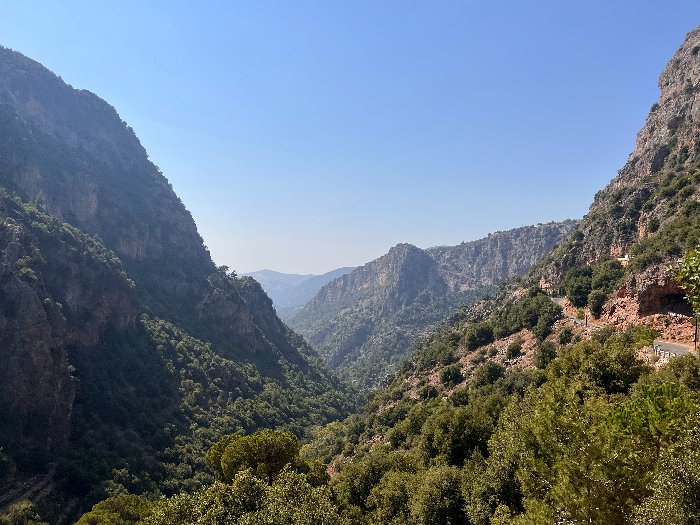
View of the Qadisha Valley in Lebanon. During our pilgrimage to Lebanon in September 2022, our Friends of Lebanon pilgrimage visited this valley, where St. Charbel (1838-1898) spent his life in prayer and contemplation, and where he is buried.
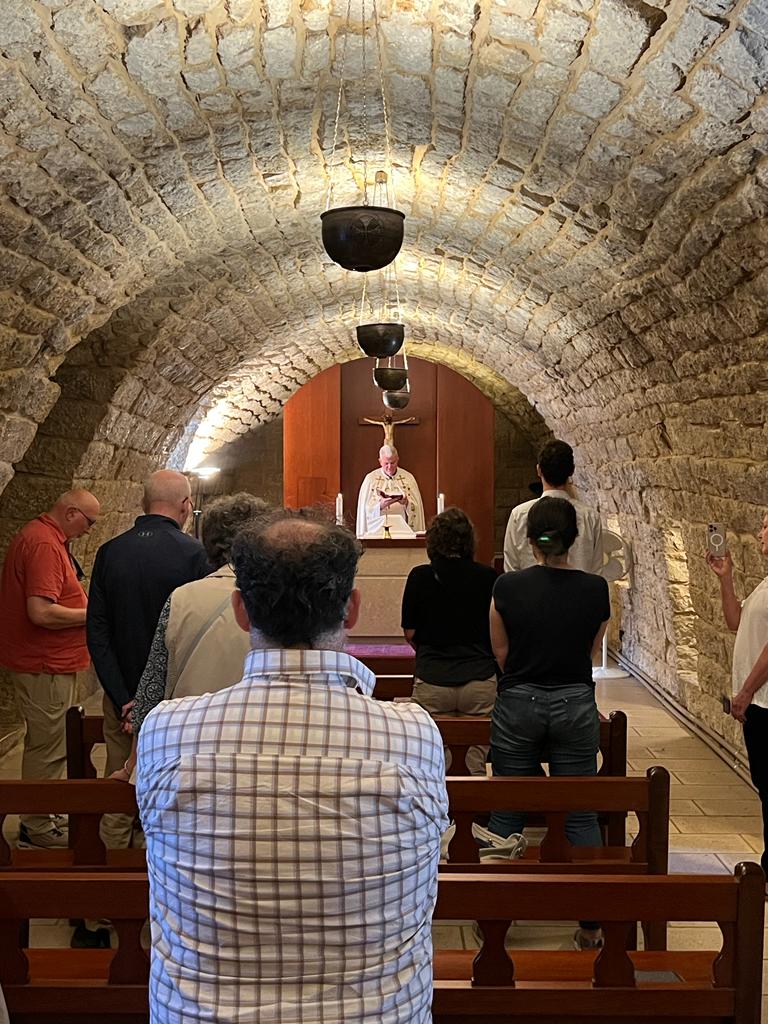
Fr. Jim O’Neal, one of our Friends of Lebanon and the chaplain of our pilgrimage group, celebrating Mass in a chapel near the tomb of St. Charbel in the Qadisha Valley, Lebanon, on September 24, 2022. The group prayed to St. Charbel, asking him to intercede to bring peace, prosperity and happiness to Lebanon
Lebanon Report 2023, #3: Saturday, April 1
Are The Lebanese Happy? A New U.N. Report Says… Not So Much
A new report from the United Nations, released March 27, has revealed a rather dire state of affairs for Lebanon: the country finished second-to-last in the 2023 “World Happiness Report.” (link)
At the same time, other — contested — reports have re-animated a long-simmering debate in Lebanon about the country’s shifting demographics, with some saying the Christian population has dropped below 20%, though most say this figure is not accurate and that the Christian population remains close to 35% (link).
The under 20% figure was cited in a February TV program by Lebanon’s interim Prime Minister, Najib Mikati. Mikati flew to Rome in late March and met with Pope Francis on March 26. The communiqué on their meeting noted the concern expressed by the Holy See “regarding the difficult socio-economic situation faced by the Lebanese population, aggravated by the current institutional stalemate of the country as it urgently awaits the election of a new President of the Republic” and “the need for peaceful coexistence among Lebanese of different faiths to be strengthened in order to guarantee peace and stability for the entire region” while “emphasizing the importance of the inalienable presence of Christians in Lebanon and throughout the Middle East.” According to the Holy See Press Office, Pope Francis offered Prime Minister Mikati the gift of a bronze work entitled “Social Love,” depicting one child helping another child up, with the inscription “Loving Helping”; as well as several volumes of papal documents, a copy of this year’s Message for Peace, the Document on Human Fraternity, and a book on the Statio Orbis of 27 March 2020. For his part, the Prime Minister presented the Holy Father with a stone holy water stoup with an image of Our Lady of Sorrows (link).
The U.N. “happiness” report, released on March 20, compared the amount of individual “happiness” in 137 countries. It used data from the Gallup World Poll, which asked up to 1,000 residents of each country surveyed to rank their own lives and societies in terms of criteria such as social support, freedom to make life choices, and perceptions of corruption. Out of the 137 countries surveyed, Lebanon came in 136th in the poll. The study authors wrote, “War-torn Afghanistan and Lebanon remain the two unhappiest countries in the survey, with average life evaluations more than five points lower (on a scale running from 1 to 10) than in the 10 happiest countries.”
The reason for the emigration crisis: a gap between reality and expectations
The data from this U.N. report go a long way in explaining why Lebanon is undergoing an emigration crisis. On the long-running American radio show Car Talk, the brothers Tom and Ray Magliozzi memorably defined happiness as “reality minus expectations,” and it is hard to imagine a greater gap between reality and expectations than what we currently find in Lebanon.
On the one hand, the country’s history as an open, tolerant, multi-confessional — and, most importantly, free — society is still palpable in everyday life. Just a few years ago, Lebanon’s universities and hospitals — most of them founded and run by Catholic religious orders — were still looked to as a model for the entire Middle East, due to the undeniable competence and high level of education of the Lebanese people.
When I traveled to Lebanon last fall as part of our Urbi et Orbi Pilgrimage to Lebanon, people we met everywhere spoke, not of implementing any kind of utopian vision, but simply of restoring, in some way, what had been lost.
In other words, the expectations of the Lebanese for their lives and their country are already high, because in their own lifetimes, they have personally experienced and contributed to a thriving society that was unique in the Middle East.
In the face of these expectations, the reality is even more disappointing. Even setting aside the larger geopolitical tensions in the region and Hezbollah’s “state within a state” in southern Lebanon, Lebanon has three major problems at present.
First, the Parliament has failed to choose a president in the five months since the former president, Michel Aoun, left office in October 2022.
Second, various influential factions within the government have prevented the country’s judiciary from completing an investigation into the causes of the August 4, 2020 port explosion — a huge physical and psychological wound on the city of Beirut, which continues to affect all who experienced it to this day.
Third, an economic and financial crisis brought about by the country’s inefficient banking sector, characterized by runaway inflation and scarcity of basic goods and utilities like gas and electricity, continues to render the day-to-day life of ordinary Lebanese an almost impossible challenge.
Our message: Lebanon must be supported
Our message is very clear — Lebanon must be supported.
The distinctive element we must support is the Christian community, a community which goes back 2,000 years to the earliest Christians in the decades following the life of Jesus — some of whom may have met Jesus during his time spent in visits to the cities of Tyre and Sidon, now part of modern-day Lebanon. Members of this community, the Catholic Maronites, still sing hymns in Aramaic, the language that Jesus spoke. It is essential for the global Christian community that this tradition be preserved.
In fact, Lebanon has a unique mosaic of Christian traditions which include Syriac and Greek Orthodox Christians, all indigenous to the country and region and all with their own unique traditions, as well as the predominant group, the Maronite Catholics.
This mosaic, together with the Sunni and Shia Muslims, and the Druze communities, creates the unique, pluralistic structural reality of Lebanon which makes the country even more than a country: Lebanon in fact is a message to the world of the possibility that various different religious groups can live in peace together.
This is why Lebanon must not fail.
If you would like to support our work for the implementation of this vision for Lebanon — and for the entire Middle East — please support our “Friends of Lebanon” initiative by clicking here. —Christopher Hart-Moynihan
Here below are the stories of three more students who were helped by Friends of Lebanon scholarship funding in 2022 We have helped a total of 132 students with scholarships since August 2020. Your support helps us keep these young people in school. (link)
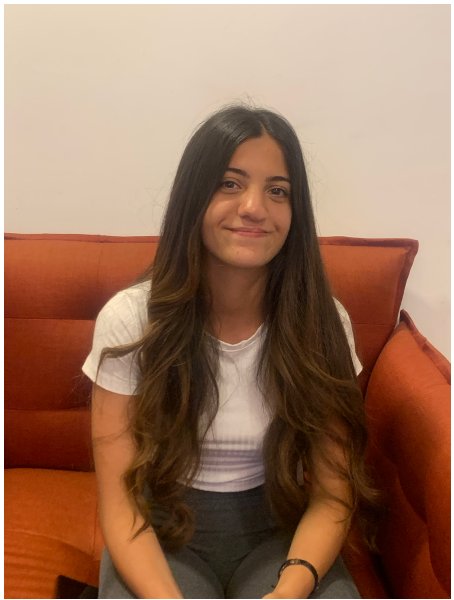
Maria
Maria’s dad died when she was only 4 years old, so her only support is her mother, who works part-time at a kindergarten.
Maria was born with several health problems. Because of these issues, she has had 12 surgeries. She is now 15 years old, and she will have four more surgeries over the next four years.
Maria is a sports enthusiast who loves gymnastics and dreams of becoming a track and field athlete. But she is struggling to realize this dream due to her health issues and the financial problems that her family has.
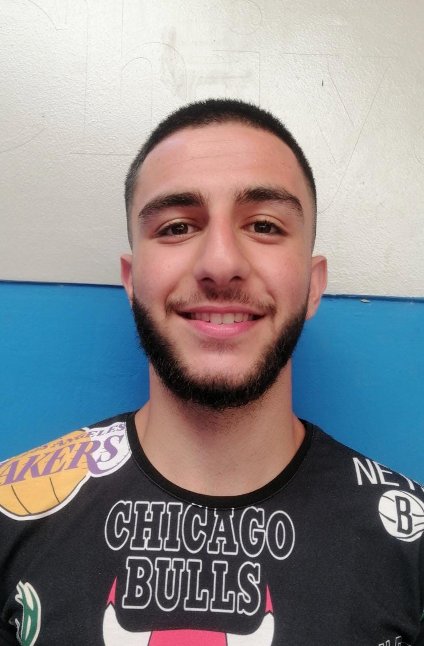
Charbel Robert
Charbel’s father is a retired army officer. While this would ordinarily mean that his family would have a comfortable life, the value of his pension has decreased exponentially following massive inflation and Lebanon’s economic collapse. He is now working again, as a security officer. Charbel’s mother is unemployed.
Charbel is a very positive and level-headed student who is known to be kind and hard-working. He also has a sister.
Giovanni
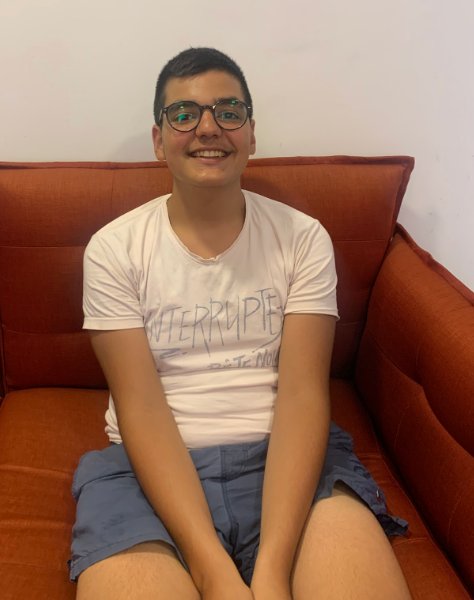
Giovanni (nicknamed Gio) is described by his friends and family as a very helpful and kind human being. He has been a scout since a very young age and he is also a volunteer with a Christian youth organization.
Giovanni lives with his father, who works in the EDL (Lebanese Electricity) industry, his mother, a stay-at-home mom, and his brother.
The family helps in supporting Giovanni’s grandfather, who lives in a senior-care facility. Due to the economic crisis, Gio’s father has been struggling to make enough money to sustain a good life for his family. His only goal in life is to keep his children in school and university.
Gio loves sports and his dream is to one day become a physical therapist and trainer.
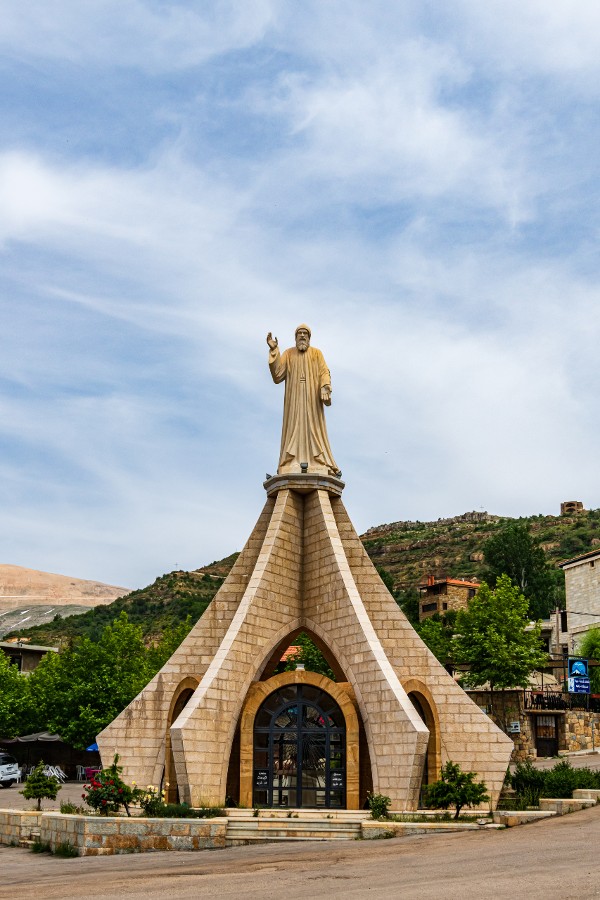
Join us on our 2023 Inside the Vatican Pilgrimage to Lebanon!
Lebanon is a small, beautiful country of seacoasts, hills, mountains and rivers and majestic cypress trees which has a history stretching back thousands of years, to the Phoenicians and the invention of writing itself in Byblos.
Tucked in between Syria and Israel, the country is a crossroads between Asia and Europe, between the Christian, Muslim and Jewish worlds. Christians have been here since the very beginning, and the Maronite Catholics are a treasure in the global Catholic community.
Many have reflected on the unique situation and mission of the country as a special place of dialogue and living together which deserves to be supported and protected.
Our trip is not only a pilgrimage to holy places and shrines, but also a time for us to go within, toward one place only — toward the heart of God, to that place where we find our own personal unity with Him.
Our itinerary is a living itinerary. Each day could present unexpected encounters. Our prayer and hope is that we allow the Holy Spirit to be our guide.
Come with us to Lebanon to encounter this ancient land where Jesus walked and to meet modern day saint!
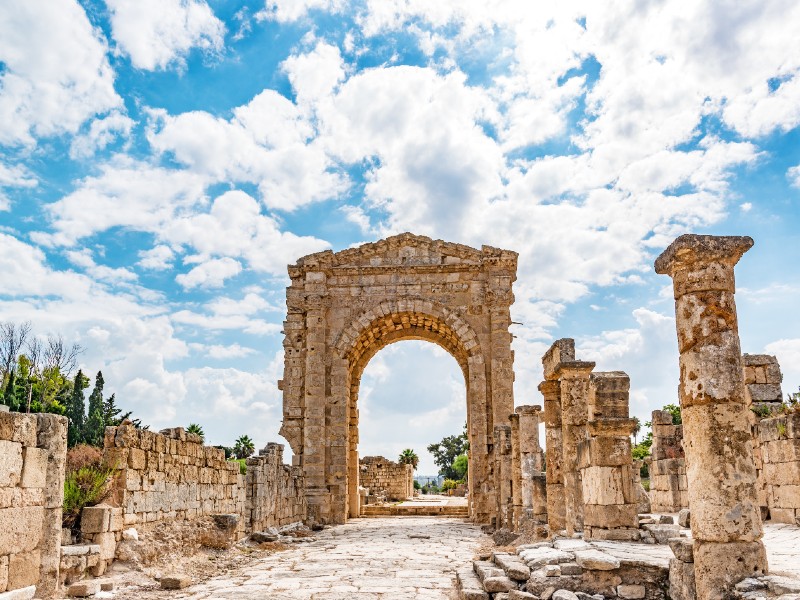
Unity Among Christians
In conversations with our friends on the ground in Beirut, with the Friends of Lebanon who came on pilgrimage with us last fall, with members of the Friends of St. Charbel (another organization doing important work in Lebanon) and with the group In Defense of Christians, we have concretized a sort of long-term “needs assessment” for Lebanon.
All of these groups agree on one thing: Lebanon can only survive as a country if there remain present in the country a certain “critical mass” of Christians. It is the Christian presence that makes it possible for Lebanon to be a message for the world — a message that it is possible to live together.
Almost 10 years ago, in 2014, Habib C. Malik described the impact of the Christian presence on the other religious communities in Lebanon:
“Even Lebanon’s Muslims began to take on a special character that set them apart from their coreligionists in the wider Arab milieu,” Malik wrote. “Having lived for generations in close proximity with free and generally secure indigenous Christians, these Muslims gradually acquired the external trappings as well as the mindset of westernized locals. Subtle sociological transformations occurred mainly among educated urban Muslims in Lebanon that reinforced pluralist acceptance of diversity and promoted a live-and-let-live attitude with respect to those of differing creeds.”
This special “Pearl of the Middle East” was established more than a century ago with three primary groups, Christians (primarily Maronite Catholics and various Orthodox Churches), Sunni Muslim and Shia Muslims, along with a number of smaller groups.
If the number of Christians declines, the balance of these groups will be diminished.
As the number of Christians who emigrate increases, it becomes more important to support them — not less.
I spoke recently with a prominent Maronite Christian in Lebanon, and asked him what is the most important thing the Christian community needs to stay in Lebanon under such difficult, almost unlivable day-to-day conditions.
“Christians should be supported,” my friend said. “By the West or by somebody else. Tell them there is a Christian stronghold in Lebanon. The more people get involved in this knowledge — that there is still a stronghold in the Middle East — the more we feel that someone like you is thinking about us and supporting us. That is very important. I receive letters every day saying, ‘We are praying for you.’ This is great support.”
A “Day for Lebanon” in September 2023, centered around St. Charbel
During a January trip to the United Kingdom, Patriarch Bechara Boutros al-Rahi of the Maronite Catholic Church gave a speech to a group called Fellowship and Aid to the Christians of the East (link).
In it, he revealed that he had submitted a formal request to the Secretary-General of the United Nations, Antonio Guterres, asking for a UN conference to be held in Lebanon.
The conference, the Patriarch stated, ought to focus on establishing a roadmap for the repatriation of Palestinian and Syrian refugees living in Lebanon, as well as drafting a Security Council resolution confirming Lebanon’s political neutrality.
As a group of concerned “Friends of Lebanon,” we would like to see the United Nations follow up on this request from Lebanon’s spiritual leader and begin organizing such a conference.
While the two issues mentioned by Patriarch Rai are hugely complicated, they must be addressed through a process of dialogue between Lebanon’s factions before it is too late.
A certain degree of unity is necessary for such a dialogue to take place.
This is why we have proposed a one-day conference, to be held this September, focusing on great spiritual and cultural figures in Lebanon.
One individual who has the capacity to unite Lebanese of all religions is St. Charbel.
The more we have learned about this remarkable saint over the past several years, the more we have become convinced that his life and miracles can be a source of hope as Lebanon and the greater Middle East traverse a period of great suffering.
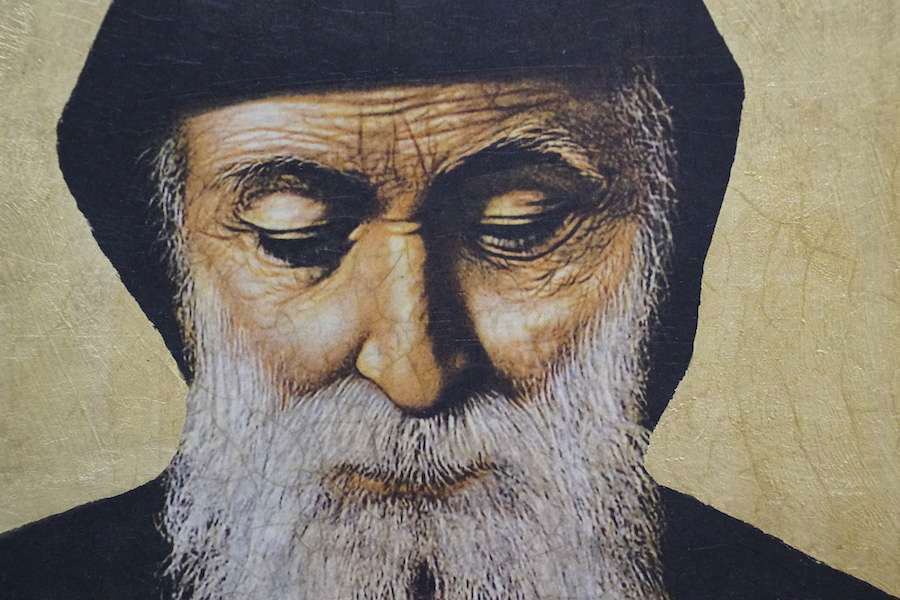
St. Charbel of Lebanon, the most beloved saint from the Land of the Tall Cedars. St. Charbel is known in Lebanon for the miraculous healings of those who visit his tomb to seek his intercession – both Christians and Muslims. He is “the Lebanese saint who unites Christians and Muslims” (link) (Photo by Hanna Brockhaus, Catholic News Agency)
Latest Documented Miracle of St. Charbel, the “Padre Pio” of Lebanon
I am ending this report with another story that I found while researching the miracles of St. Charbel.
The Lebanese saint who unites Christians and Muslims (link)
Hannah Brockhaus (CNA)
July 25, 2019
ANNAYA, LEBANON — St. Charbel Makhlouf is known in Lebanon for the miraculous healings of those who visit his tomb to seek his intercession – both Christians and Muslims.
“St. Charbel has no geographic or confessional limits. Nothing is impossible for [his intercession] and when people ask [for something], he answers,” Fr. Louis Matar, coordinator of the Shrine of St. Charbel in Annaya, Lebanon, told CNA.
Speaking in Arabic with the help of an interpreter, Matar said the shrine, which encompasses the monastery where the Maronite Catholic priest, monk, and hermit lived for nearly 20 years, receives around 4 million visitors a year, including both Christians and Muslims.
Matar, who is responsible for archiving the thousands of medically-verified healings attributed to the intercession of the Maronite priest-monk, said that many miraculous cures have been obtained by Muslims.
Since 1950, the year the monastery began to formally record the miraculous healings, they have archived more than 29,000 miracles, Matar said. Prior to 1950, miracles were verified only through the witness of a priest. Now, with more advanced medical technology available, alleged miracles require medical documents demonstrating the person’s initial illness and later, their unexplainable good health.
One of the miracles documented by Matar at the end of December, when he spoke to CNA, was that of a 45-year-old Italian woman. Suffering from a neurological disease, she was hospitalized after it was discovered she had tried to commit suicide by consuming acid.
In the hospital, the doctors discovered that the damage to her esophagus and intestines was so extensive, “the last way possible to cure her was believing in God and praying,” Matar commented.
The woman’s parents began to pray, inviting others to pray with them. A religious sister of the Maronite rite heard about the prayer request and gave them holy oil from St. Charbel. After they spread the oil on the suffering woman’s stomach, chest, and head, she was cured.
This was just one of seven miracles archived in December, Matar said, calling each one “a phenomenon.”
“St. Charbel is a tool to reach God,” he said.
The Shrine of St. Charbel is composed of the Monastery of St. Maron, where the saint lived for 19 years with great devotion to prayer, manual labor, and contemplative silence; and the nearby hermitage where he lived a rigorous asceticism and profound union with God for the last 23 years of his life.
At the monastery, pilgrims can visit a church built in 1840, a small museum with artifacts and relics from the saint, and the site of his first grave. St. Charbel’s tomb, since 1952, is located inside a special cave-like chapel built into the property.
Even while he was alive, Charbel’s superiors observed God’s “supernatural power” at work in his life, and even some Muslims knew him as a wonder-worker.
Deeply devoted to God’s Eucharistic presence, he suffered a stroke while celebrating the Divine Liturgy of the Maronite Catholic Church on December 16, 1898, dying on Christmas Eve of that year. He was canonized in 1977 by St. Pope Paul VI.
St. Charbel
One of the most beloved figures in Lebanon is St. Charbel, the Maronite monk who was born in 1828 in Bekaa Kafra, high above the Qadisha Valley (the Lebanese writer and artist Kahlil Gibran was born 55 years later, in 1883, in Bsharri, the town that faces Bekaa Kafra across the valley).
St. Charbel was born into a Maronite family and given the name Youssef Antoun Makhlouf. His parents were Antoun Zaarour Makhlouf and Brigitta Makhlouf.
When Charbel was just 3 years old, his father, Antoun Makhlouf, was taken to perform forced labor for the army of the Ottoman sultan, who at them time ruled over all of modern-day Turkey, Syria, Lebanon, Israel, and Greece. Antoun passed away shortly afterwards.
After the death of his father, Charbel was raised by his mother and later his stepfather, a man who took Holy Orders and became the parish priest of Bekaa Kafra.
Charbel was a quiet and thoughtful young man who felt called to the spiritual life from a young age.
At age 21, he left his family and went to live with the monks of the Lebanese Maronite Order in Mayfouq, near the city of Byblos.
Some time afterwards, he transferred to the Monastery of St. Maroun in Annaya, a small town in the mountains east of Byblos.
It was here that Youssef Antoun Makhlouf was given the name Charbel, which, according to sources, means “Story of God” in the Syriac language.
In 1853, he took his final monastic vows and joined the order in Annaya, where he would spend most of the rest of his life.
Charbel’s fame for holiness and miracles grew during his life, and even more after his death.
Many years after his death, his body was exhumed and found to be incorrupt.
To this day, he has been credited with more than 29,000 miracles, for people from Christian, Muslim, Jewish, and Buddhist religious backgrounds.
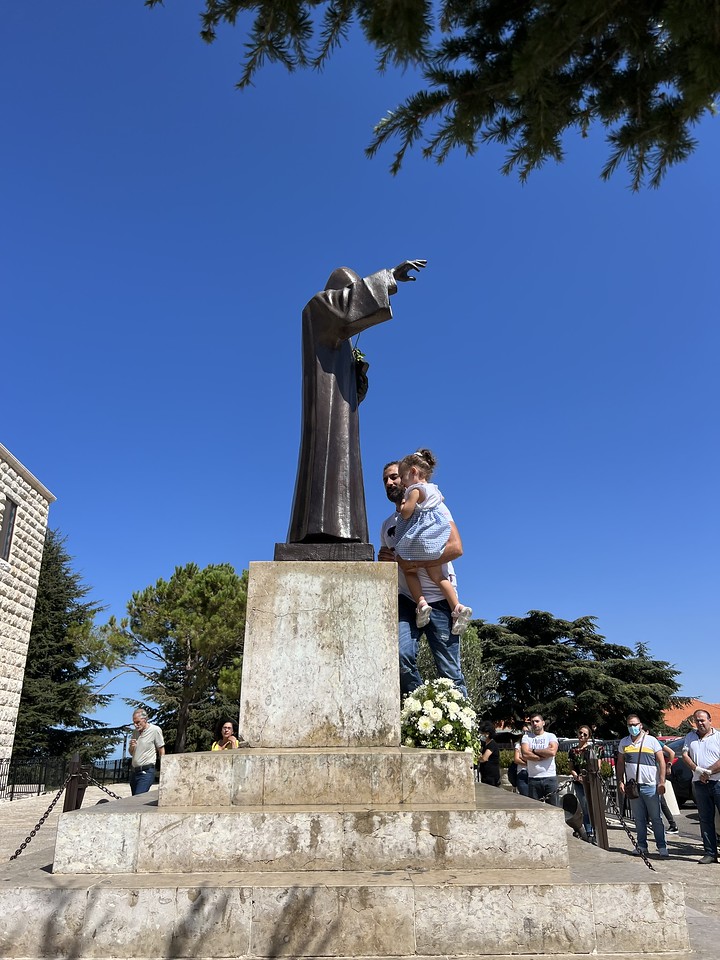
A father and daughter at the tomb of St. Charbel in Annaya, Lebanon. This photo was taken during our Friends of Lebanon pilgrimage in September 2022
Please consider becoming a “Friend of Lebanon,” and help us to bring “short-term help” and “long-term hope” to the land where Jesus Christ walked and performed miracles.
As a “Friend of Lebanon,” you will be able to participate in our Zoom calls with the people we are working with in Rome, Beirut, and throughout Lebanon to support Christians in their ancient homeland.
Please enjoy a complimentary digital edition of Inside the Vatican Magazine by clicking here.
Please consider joining us.
Christopher Hart-Moynihan
Director of Programs
Urbi et Orbi Communications
